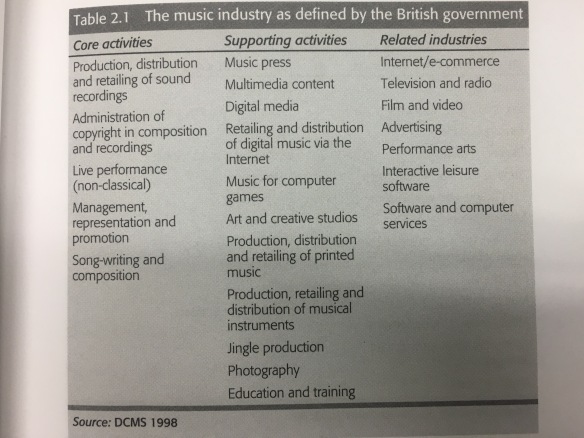The music industry is not one, but a number of different industries that are all closely related but which at the same time are based on different logics and structures. There are many different interpretations of the definition of the music industry.
Several attempts have been made to define and structure the different parts of the music industry. one such attempt has been presented by the UK government’s department for culture, media and sport, which over the years has presented a number of reports on the state of the UK music industry (DCMS 1998).
 Source: Wikström (2013, p. 47)
Source: Wikström (2013, p. 47)
According to Wikström (2013) cited in Negus (1992), approaches the definition issue from different perspective. he describes the music industry as ‘concerned with developing global personalities which can be communicated across multiple media: through recordings, video, films, television, magazines, books and via advertising, product endorsement and sponsorship over a range of consumer merchandise’.
The generally consider the music industry to be made up of three parts: recording, publishing and live performance (Hesmondhalgh 2015). Leyshon (2001) suggests the music economy consists of a series of sequential processes. The first network is one of creativity, the second is of reproduction, the third is distribution and the last is a network of consumption.
The music industry shapes the way in which pop music is produced and disseminated to consumers. In the music albums sold and broadcast before the broadcast, agents, video producers, graphic artists, text editor, record line, stage workers, truck drivers, T-shirt companies and music hardware production company, are in today’s popular music production and publicity process plays a vital role. One has been extended to many business and culture-oriented industries, it is difficult to divide the line (Starr, L. and Waterman, C. 2006, chapter 9).
Bibliography:
Hesmondhalgh, D. (2015). The cultural industries. 1st ed. Los Angeles [etc.]: SAGE.
Starr, L. and Waterman, C. (2006). American popular music. 1st ed. New York: Oxford University Press.
Wikström, P. (2013). The Music Industry: Music in the Cloud, 2nd Edition. 1st ed. Cambridge: Polity Press.

Indeed there is no one definition of the music industries but the plurality is certain. Quite often, within these industries, the overlapping nature of job roles and productive, distributive and consumptive processes have led the way for perhaps one of the most true forms of entrepreneurship to happen. Because of the ’emotional economy’ of music, and the ever-changing trends and uncertainty due to technology, there is no set formula. There is still the connotation of ‘magic’, and the inexplicable. Music is art. Art is hard to measure. tastemakers aren’t always right. It is for all of these reasons that music and the intertwined industries that accompany it requires passionate and adaptable personalities, nowadays often freelance independents. I would recommend Anderton, Dubber and James (2013), especially chapters 1 & 2 to explore the evolution and risk management of these industries, as they change ever more from the traditional model.
LikeLike
Bibliography:
– Long, P. & Barber, S. 2015, “Voicing passion: The emotional economy of songwriting”, European Journal of Cultural Studies, vol. 18, no. 2, pp. 142-157
– Anderton, C., Dubber, A. & James, M. 2013, Understanding the music industries, SAGE, London.
LikeLike
You noted the fluidity of the music industries when it comes to defining what is and isn’t part of the ‘music industry’ – which is the main point to take home. I think one thing that hasn’t been touched on as much as it should have in popular music academia when it comes to defining the music industries is the ‘fan experience industry’. I believe this to be an extension of the ‘merchandise industry’ in essence – rather than simply a t shirt or wristband, a lot of artists now offer a huge amount of varied products, experiences and intimate concerts to create revenue. Examples could be Don Broco’s ‘Brew-Co’ campaign, where they’ve been selling hot chocolate and mugs, or Dance Gavin Dance’s branded pico de gallo (based on a song lyric from their latest album).
LikeLike
As someone who is often debating whether they’re part of the journalism industry, the music industry, or both, I agree with the notion that essentially all parts of the process of production, distribution, and consumption are vital, as no matter where they sit industry-wise, they benefit the music industry in some shape or form. As you’ve stated, the music industry is indeed fluid and ever-changing, the definition of it and what constitutes a music industry role is perhaps the most elusive, almost undefinable. Along with the chapters from Anderton, Dubber, and James (2013) that Shelley recommended in her comment, I would recommend reading Wall’s (2013) book, Studying Popular Music Culture, whilst it doesn’t quite answer what exactly a music industry role is, or defines it in anyway, it discusses and solidifies the idea that popular music, and the industry surrounding it, is as fluid and as flowing as running water: it is what we ourselves see it to be.
LikeLike
I really like the strong opening stating that the music industry is not one but many industries that share a similar interest. It would be more engaging as a post to see you talk about how you would place yourself within the music industry and weigh in your opinions in relation to some of the references you have used to get a true understanding of what you believe.
LikeLike